Parts of an Airplane and Their Function
There are many parts of an airplane and each has its own specific purpose. Let’s look at the main components of an airplane and get a better understanding of their function.
Fuselage
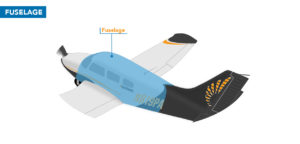
The plane’s body, or fuselage, holds the aircraft together, with pilots sitting at the front of the fuselage, passengers and cargo in the back.
Cockpit
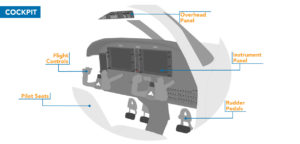
The cockpit is the area at the front of the fuselage from which a pilot operates the plane. The cockpit contains the:
- Instrument panel
This is similar to a car’s dashboard, providing the pilot with information about the flight, the engine and the circumstances of the aircraft. Depending on the aviation electronics (avionics) installed in an aircraft this may be on an interactive screen or using the typical ‘6 Pack’ for key pieces of information. - Flight controls
In the cockpit are two seats, one for the pilot and the other for the co-pilot. - Pilot seats
In the cockpit are two seats, one for the pilot and the other for the co-pilot. - Rudder pedals
Rudder pedals control yaw in flight and are used for steering on the ground during a taxi. - Overhead panel
The overhead panel contains aircraft systems, such as air conditioning, electrical, fuel and hydraulics. - Side consoles
Side consoles are for communication instruments and documentation, depending on the aircraft.
Each of these parts of an airplane are critical in the different phases of flight.
Wings
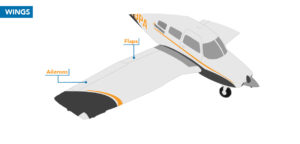
An aircraft’s wings are critical to flight through the production of lift, but they have many parts of the wing to control this lift amount and direction.
- Ailerons
Ailerons are one of the three primary control surfaces that control a plane (along with the Elevator and Rudder) and are located on the trailing edge of the wing to help control the roll of a plane. When a pilot turns to the left in the cockpit, the left aileron goes up, reducing lift on that side, and the right aileron goes down, increasing lift causing that side to rise. This causes the plane to roll to the left and begin a turn. - Flaps
Flaps, like ailerons, are located on the trailing edge of the wing. Unlike ailerons, the flaps move symmetrically on each side and create more lift and drag. Flaps are typically used during takeoff and landing, when aircraft speeds are lower, to create additional lift and reduce stall speeds. - Winglet
On an airliner, the tip of the wing is bent up. This is known as a winglet. Winglets were created to reduce induced drag. - Slats
Slats are similar to flaps, only located at the front of the wing (a leading-edge device) and change a wing’s shape temporarily to increase lift. - Spoilers
Spoilers are used to help the aircraft descend and reduces the lift component of an airfoil. This allows the plane to descend and lose altitude without gaining airspeed.
Tail (Empennage)
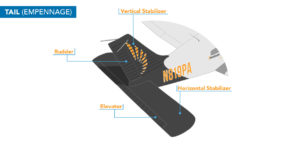
An aircraft’s tail is mainly used for stability, as well as creating lift in combination with the wings. It’s comprised of several parts.
- Horizontal Stabilizer and Elevator
The horizontal stabilizer keeps the airplane’s nose from moving up and down (pitch). The hinged part on the horizontal stabilizer is the elevator and is one of the primary flight controls. When the pilot in the cockpit pulls back on the yoke, the elevators go up, causing more force to push down on the tail, lifting up the nose of the aircraft. Raising the nose changes the angle of attack on the wings, increasing lift. - Vertical Stabilizer and Rudder
The vertical stabilizer allows the airplane to weathervane into the relative wind. This helps prevent the side-to-side motion of the aircraft’s nose (yaw). The rudder, which is the primary flight control on the trailing edge of the vertical stabilizer, is controlled in the cockpit by the pilot using the left and right pedals. When the pilot pushes the left pedal, the rudder deflects to the left, pushing the tail right and the nose to yaw left. Using the rudder in combination with the ailerons causes coordinated turns by the aircraft.
The tail and its various parts are essential to the aircraft, helping to keep the plane on course.
Engine(s)
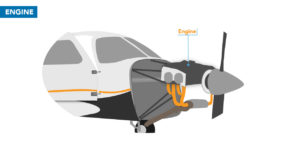
The engine(s), or powerplant, of an aircraft creates thrust needed for the plane to fly. Generally speaking, there are two types of aircraft engines, reciprocating and turbine. With reciprocating engines, air flows into the engine, is compressed and mixed with fuel and an electric spark to combust, with exhaust gases leaving the back of the engine through the manifold. The engine spins the propeller which then creates thrust to move the plane forward. Alternatively, with a turbine engine, the action of compressing air, mixing with fuel, ignition and exhaust are similar but occur inline. In this case the power is generated by the air being exhausted from the engine.
Propeller
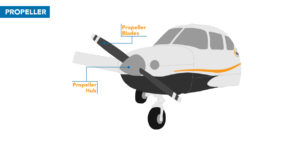
An aircraft’s propeller(s) are airfoils, similar to a wing, installed vertically to create thrust to drive the plane forward. Attached to the engine, they spin quickly, creating lift from the pressure difference they create, only instead of this lift causing the plane to move upwards, it drives the plane forward creating thrust. This thrust and forward motion in turn causes air to pass over the wings, creating the vertical lift.
Landing Gear
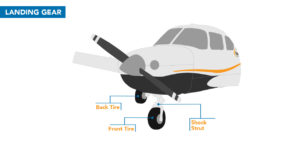
Landing gear is located under the belly of the plane consisting of a wheel and strut to soften impact with the ground and may be retractable into the fuselage. Tricycle type wheels are common for general aviation with one wheel at the front and two behind or the reverse for tailwheels with two wheels at the front of the plane and one under the tail.
All parts of an airplane are crucial for conducting safe flight. A huge responsibility pilots take on is making sure all aircraft components are in excellent condition before embarking on their flight journey.

